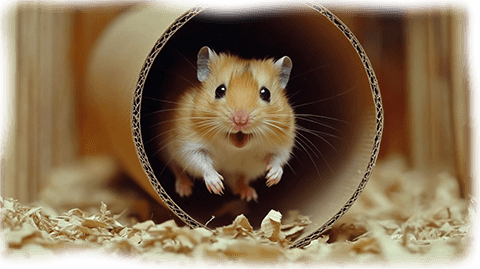How to Train a Hamster: A Comprehensive Guide
Training a hamster may not be as common as training a dog or cat, but it’s absolutely possible—and rewarding! Hamsters are curious, intelligent creatures, and with the right approach, you can teach them basic behaviors, tricks, and, most importantly, to be comfortable around you. Patience, consistency, and positive reinforcement are key. Let’s break down how to train your hamster and provide you with helpful tips and resources to ensure success.
Why Train a Hamster?
Training a hamster has several benefits. It helps build a trusting relationship between you and your pet, reduces their stress, and improves handling. A trained hamster is generally calmer, making things like cage cleaning and vet visits much easier.

Before You Start: Key Considerations
- Choose the Right Time – Hamsters are nocturnal, meaning they are most active during the evening. Make sure to approach training when your hamster is awake and active.
- Patience is Key – Hamsters have short attention spans and training them will take time. Start with brief, consistent sessions (around 5-10 minutes).
- Positive Reinforcement – Always use positive reinforcement, like treats (Amazon affiliate link), to encourage good behavior. Never use punishment, as this can stress your hamster and cause fear.
Steps for Training Your Hamster
Building Trust
The first step in training your hamster is earning its trust. Since hamsters are prey animals, they are naturally cautious of humans. Building a trusting bond is essential before moving on to more advanced training.
- Let Them Get Used to You – Spend time near your hamster’s cage and speak softly to them. Avoid sudden movements.
- Offer Treats – Offer your hamster treats from your hand, allowing them to come to you. Over time, they’ll associate your presence with positive experiences.
- Hand Feeding – Gradually start feeding your hamster by hand to build comfort with being close to you. Use small, hamster-safe treats like sunflower seeds or tiny pieces of fruit.

Taming and Handling
Once your hamster trusts you, you can begin handling them. This is crucial for both their comfort and for basic training.
- Start Small – Begin by letting your hamster walk onto your hand while it’s still in the cage. Let them explore your hand and arm at their own pace.
- Lifting – Once your hamster is comfortable, gently lift them out of the cage. Be sure to support them with both hands. Hold them close to your body to avoid accidental falls.
- Practice Regularly – Regular handling is important to keep your hamster tame. Short daily sessions are better than long, infrequent ones.

Litter Training
Litter training a hamster can make cage cleaning much easier. While not all hamsters take to this quickly, it’s worth trying.
- Identify a Spot – Most hamsters naturally pick a spot in their cage to relieve themselves. Once you’ve identified this spot, place a small litter box or container in that area.
- Use Soiled Bedding – Put a bit of soiled bedding or droppings into the litter box to encourage them to use it.
- Reinforce Behavior – When your hamster uses the litter box, reward them with a treat to reinforce the behavior.
Teaching Basic Commands
Hamsters can learn basic commands like “come” or “stand up” with a little practice and patience.
- Teaching “Come” – Call your hamster’s name and use a treat to lure them toward you. When they reach you, give them the treat and say “come.” Repeat this daily, and eventually, they’ll associate the word with the action.
- Teaching “Stand Up” – Hold a treat above your hamster’s head. When they stand on their hind legs to reach it, say “stand up” and give them the treat. With enough repetition, your hamster will stand on command.
Teaching Fun Tricks
Once your hamster has mastered basic commands, you can move on to fun tricks like running through tubes or rolling over.
- Running Through a Tube (Amazon affiliate link) – Use a toilet paper roll or small tunnel as an obstacle. Lure your hamster through the tube with a treat, and reward them once they complete the task. Repeat the process until they learn to go through the tube without the lure.
- Rolling Over – While your hamster is standing on its hind legs, gently encourage it to roll to one side using a treat. Once they roll over, reward them and say “roll over.”

Common Training Challenges
Training a hamster isn’t without its challenges, but with persistence, you can overcome them.
- Short Attention Spans – Hamsters have short attention spans, so keep training sessions brief—no more than 5-10 minutes at a time.
- Skittishness – Some hamsters are naturally more skittish or nervous. For these hamsters, take it slow, and focus on trust-building before moving on to more complex tasks.
- Not Food Motivated – If your hamster isn’t motivated by treats, try different types of rewards such as toys or soft petting, or experiment with new, hamster-safe treats.
Helpful Resources for Hamster Training
- Books: “Hamsters for Dummies” (Amazon affiliate link) by Sarah Montague offers great beginner tips for training and care.
- YouTube: Search for reputable hamster trainers who demonstrate hands-on techniques.
- Forums: Join hamster forums like “Hamster Central” to discuss training tips and share experiences with other hamster owners.
Conclusion
Training your hamster can be a rewarding experience that strengthens the bond between you and your pet. Remember, each hamster is unique, and the key to success is patience, consistency, and positive reinforcement. Start with trust-building, move on to handling and litter training, and eventually work your way to basic commands and tricks. With dedication and time, your hamster will become a well-trained, confident companion.
Affiliate Disclosure
This post may contain affiliate links, which means I earn from purchases made through links. Please see the privacy policy page for more details.





